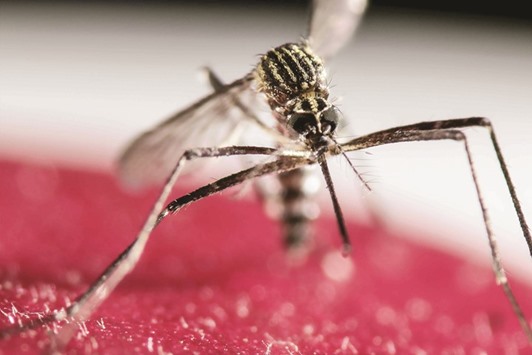In 2007, physicians working on a remote island in the western Pacific Ocean reported an outbreak of an illness with flu-like symptoms similar to dengue fever, a debilitating viral disease transmitted by mosquitoes and well documented since the 18th century.
But the illness observed by doctors on Yap Island in Micronesia seemed different than dengue — with sudden onset of rash, joint pain or red eyes, and no cases of haemorrhagic fever.
Patient blood samples sent to the federal Centers for Disease Control and Prevention would later confirm the first recorded outbreak of what was then an obscure pathogen.
“We didn’t have any idea that it was Zika virus,” said Lt. Col. Mark Duffy of the US Air Force, one of the lead physician researchers dispatched to investigate the mystery illness in June 2007. “There was just a paucity of literature that was out there.”
Until then, Zika had been something of a sleeper virus. Only 14 cases of human Zika disease had been documented prior to 2007, and all of them were in Africa and Asia, according to an article on the Yap Island upsurge published in the New England Journal of Medicine in 2009. Researchers identified 49 confirmed cases of Zika, and estimated that 73 percent of the population had been infected with the virus.
Nearly nine years after the first Zika outbreak was documented by Duffy and a team of disease detectives — a collaborative effort involving the CDC, the World Health Organisation and the nonprofit Pasteur Institute — the virus has spread rapidly across South America and the Caribbean, triggering warnings of a global health threat.
But physicians and public health officials still lack the basic scientific research to understand precisely how Zika spreads or to establish a causal connection with a concurrent spike in microcephaly, a congenital birth defect, and other neurological disorders following outbreaks of the virus in Brazil in 2015 and in French Polynesia in 2014.
There is no tool available that allows physicians to diagnose Zika virus in the field, limiting their ability to quickly identify the disease and take action. There is no vaccine or specific medical treatment for the virus’ symptoms, which affect only one in five infected people. And it’s unclear whether the virus is transmitted only by mosquitoes, or perhaps also through sexual contact, as health officials believe occurred in Texas this year.
“We’re all steep on this dreadful learning curve,” said Elizabeth Talbot, a physician and infectious diseases expert at Dartmouth College’s Geisel School of Medicine. “There are a lot of negatives, and there are a lot of unknowns right now.”
Those unknowns, particularly the suspected link between the virus and birth defects, are precisely the reasons cited by the WHO’s Emergency Committee for declaring an international emergency for Zika on
February 1.
Catherine Spong, a physician-scientist and acting director of the Eunice Kennedy Shriver National Institute of Child Health and Human Development, said the most important unanswered question is whether or not Zika virus is causing birth defects and other neurological disorders.
“If in fact it is,” Spong said, “then we need to work through exactly when that happens and how can we prevent that.”
Duffy, the physician who investigated the Zika outbreak on Yap Island in 2007, said the team of scientists spent a month in the field studying the transmission and symptoms of the disease.
In that time, he said, the team made several important observations, including the determination that only about 1 in 5 people infected with the virus show symptoms.
Duffy surmised that the Zika virus likely arrived on the remote island via an infected monkey, an infected person or a mosquito carried aboard a cargo container or airplane.
The team determined that about 75 percent of the island’s population had been infected with Zika during the outbreak, he said, and they were the first to characterise the disease’s symptoms in a broad population.
But, Duffy said, “There wasn’t any indication at that point about the fetal anomalies or Guillain-Barre syndrome,” a neurological disorder often associated with viral infections.
The only way to prove a causal link between the virus and any of the suspected outcomes is through epidemiological research, including cohort and case-control studies, which then would require further research for prevention and treatment.
Scientific efforts, including case investigations and ecological research, already are underway to close the knowledge gap on Zika, the WHO reported.
President Barack Obama has asked Congress for $1.8 billion in emergency funding to combat the virus through mosquito control, vaccine research, education and improving healthcare for low-income, pregnant women.
The CDC also is responding to state requests for help, sending 950 Zika antibody tests to Florida at the request of Governor Rick Scott — in addition to 475 tests sent recently. Sixteen cases have been identified in Florida so far, all acquired outside the country and none involving pregnant women.
Talbot, the infectious disease expert at Dartmouth, who also is New Hampshire’s deputy state epidemiologist, said “very active investigations” into a causal link between Zika and birth defects are under way now. But, she said, the scientific community shouldn’t expect to arrive at definitive conclusions for three to six months.
Until then, she said, people worried about Zika virus should listen to what is known about transmission of the disease and its symptoms.
“Pregnant women should try to postpone travel to the affected regions,” she said. “We have confidence in that recommendation.”
Tablot added that practical advice can go a long way, including the use of insect repellants DEET or Permethrin in clothing and removing containers and places where mosquitoes breed.
“Maybe they’re not always simple,” she said, “but they are effective.” —Miami Herald/TNS

DANGER THAT LURKS: A mosquito from the genus Aedes, which can carry Zika virus.
